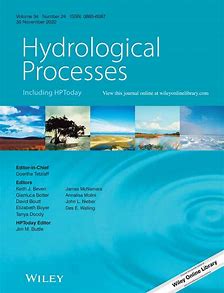- Department:(Dept. 1) Ecohydrology and Biogeochemistry
Misbalance of thyroid hormones after two weeks of exposure to artificial light at night in Eurasian perch Perca fluviatilis
In a lab study it was tested if light pollution affects thyroid hormones in Eurasian perch. The results show first signs of endocrine disruption in thyroid metabolism after a relatively short exposure of two weeks under high-intensity streetlight conditions. Misbalanced thyroidal status can have serious implications for metabolic rates as well as developmental and reproductive processes.
Using isotopes to understand landscape‐scale connectivity in a groundwater‐dominated, lowland catchment under drought conditions
The authors integrated hydrometric and isotope data to understand how droughts affect ecohydrological partitioning, hydrological connectivity and streamflow generation at the catchment scale. Groundwater recharge was lower under forest than grassland and enhanced in restored wetlands. Complex patterns of connectivity affect in-stream solute transport and interactions between land- and riverscapes.
Quantifying the effects of land use and model scale on water partitioning and water ages using tracer-aided ecohydrological models
The authors used the IGB model EcH2O-iso with isotope tracers to quantify how different vegetation communities in lowland German catchments partition rainfall into evapotranspiration and groundwater recharge. This showed that forests account for greater water losses to the atmosphere and reduced recharge. Future losses under climate change can be optimised by species selection and management.
Co-evolution of xylem water and soil water stable isotopic composition in a northern mixed forest biome
The authors investigated the co-evolution of plant xylem water and soil water stable isotopic compositions in a northern mixed forest, Canada. They showed that differences in timing and intensity of water use between deciduous and coniferous trees may account for inter-specific variations in xylem water isotopic composition providing insight into how they may respond to hydroclimatic change.
How daily groundwater table drawdown affects the diel rhythm of hyporheic exchange
With a physically based model that couples flow and heat transport in hyporheic zones, the study provides insights into hyporheic responses to daily groundwater withdrawal and river temperature fluctuations. These interactions have impacts on temporal variability of hyporheic exchange, mean residence times and denitrification potential. Improved pumping schemes can restore ecosystem functions.
Effects of the largest lake of the Tibetan Plateau on the regional climate
The authors used a coupled lake-atmosphere model to investigate the effect of the largest lake of China, the Qinghai, on the weather and climate conditions of the Tibetan Plateau. They found that the lake alters wind conditions and increases precipitation over the arid areas of the earth’s “third pole” Tibet but the effect is irregularly distributed spatially and temporally over the seasons.
Catchment functioning under prolonged drought stress: Tracer‐aided ecohydrological modeling in an intensively managed agricultural catchment
The authors investigated the effects of recent years’ droughts on ecohydrological processes in an agricultural catchment using an isotope-aided model (EcH2O-iso). Stream discharge could be sustained by deep, old groundwater, while transpiration fluxes were heavily reduced by drought stress. Crucially, tracer-based water age estimates can be used as potential indicators of drought impacts.
Soil erosion modelling: a global review and statistical analysis
67 scientists reviewed 1700 peer-reviewed articles on soil-erosion modelling. The study addresses the relevance of regions, models, and model validation and includes the open-source database.
Simultaneous attenuation of trace organics and change in organic matter composition in the hyporheic zone of urban streams
Wastewater still contains high amounts of trace organic compounds and organic matter after the wastewater treatment plant. These compounds are usually discharged to rivers with the treated water. The study shows that in the hyporheic zone of the river, i.e. the river sediment, degradation of trace organic compounds takes place simultaneously with a change in the composition of organic matter.
Stable isotopes of water reveal differences in plant – soil water relationships across northern environments
The authors compared stable isotopes of water in the plant stem (xylem) and in the soil over a complete growing season at five northern experimental sites to understand where plants get their water from and what the temporal dynamics are of such root water uptake. This paper was a main finding of an ERC Grant.








